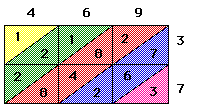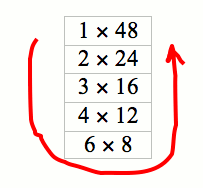September 28th, 2005

Looking at things (finger nails, the point of a pencil, flowers, leaves, dead wasps – plenty of those this Autumn weekend) with a magnifier in the range x5 to x10 can reveal a range of new detail and interesting structures.
Plenty of scope for cross-curricula themes, especially art/maths. Interestingly, when I taught keyskills application of number the easiest vocational area to find material for was Art and Design – the hardest was business studies.
Posted in Maths, Photos | Comments Off
September 26th, 2005

The way we do long multiplication (and long division for that matter) has more to do with the limitations of printing in the 1500s than anything rational.
A couple of alternatives include
The links above are from the excellent Ask Dr Math page, and I especially like the Russian multiplication page that explains why the method works.
Posted in Maths | Comments Off
September 25th, 2005
John Lambert is an intellectual property rights lawyer based in Huddesfield who is keeping an awesomely detailed blog going about recent patents and IT cases.
Posted in Forensic, Web | Comments Off
September 25th, 2005
Posted in Photos | Comments Off
September 23rd, 2005

- Factors come in pairs
- The largest factor of a number is the number, the next largest is at most half the size of the number
- Use these facts to find the factors systematically
Students can shout out factors of a number easily enough. A systematic layout for finding factors is shown in the screen grab above – I owe this one to Sue Wilding. By listing the factors in pairs, starting from 1 on the left, you can be sure of finding all of the factors of a number. When you reach a point where the two factors are the same (square numbers) or close (other numbers) you know when to stop.
The red arrow is a suggestion I give students to ‘peel off’ the factors in order of size: the factors of 48 are: 1, 2, 3, 4, 6, 8, 12, 16, 24 and 48.
Factors and Multiples contrasted
| Factors | Multiples |
| Finite number of factors for any whole number | Infinite number of multiples |
| Most factors are smaller than number – largest is number itself | Most multiples larger than number, smallest is number itself |
I usually get people to comment on the idea that you just add the number on to find the next multiple. I summarise by stressing the idea that
- factors are usually smaller than the number
- multiples are usually larger than the number
Odd number of factors
- Some numbers have an odd number of factors
- Try finding the factors of 36, 25, 81
- These are the ‘square’ numbers
Posted in Maths | Comments Off
September 23rd, 2005
A computer magazine survey reveals that nearly 60% of small to medium businesses do not keep clear records of software licences. Many businesses buy software licences with each new computer – they could get deals for a set number of ‘seats’.
If you are a small business, how do you keep track of all this?
Posted in Forensic | Comments Off
September 21st, 2005

Blogger is a free online blogging system that has recently been upgraded to include image storage space – previously the system did not have image space. Now owned by Google, Blogger is offering you a really easy way to provide information on a weekly basis for your evening class. The logo is an excellent piece of design, and the t-shirt looks cool.
We are using course blogs as a way to convince very busy teachers that using Web pages to support students will actually save them time. The investment can be less than half an hour per week per class (I’d always advise one class to begin with). The students find the site easy to manage – last week’s work is in front of them – and they will follow links you provide them with. There is a lot of good content out there, what you are contributing is your knowledge of the syllabus and careful evaluation of the material.
See also
Once the case for online support has been made, a smaller proportion of teachers will move onto much deeper systems like Moodle and the other VLEs.
Posted in ILT | Comments Off




